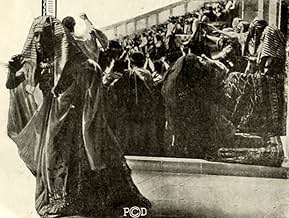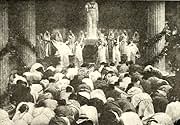PUNTUACIÓN EN IMDb
6,1/10
641
TU PUNTUACIÓN
La ciudad de Pompeya vive entregada a los placeres, las luchas de gladiadores y el culto a una divinidad. Mientras, se desarrollan varias historias de amor, traiciones y la aparición de otra... Leer todoLa ciudad de Pompeya vive entregada a los placeres, las luchas de gladiadores y el culto a una divinidad. Mientras, se desarrollan varias historias de amor, traiciones y la aparición de otra religión hasta que el Vesubio entra en erupción.La ciudad de Pompeya vive entregada a los placeres, las luchas de gladiadores y el culto a una divinidad. Mientras, se desarrollan varias historias de amor, traiciones y la aparición de otra religión hasta que el Vesubio entra en erupción.
Argumento
¿Sabías que...?
- CuriosidadesFor a while in the late summer and fall of 1913 there were two major Italian productions on this subject playing simultaneously in the US, this one produced by Ambrosio, and Los últimos días de Pompeya (1913), produced by Pasquali.
- PifiasExtras are "killed" by falling pieces of a set during the explosion scene, then appear to either get back up or adjust themselves so that they won't be trampled by other extras.
- Versiones alternativasKino International Corp. copyrighted a version in 2000 with a piano music score compiled and arranged by Beatrice Jona Affron and performed by Martha Koeneman. It was produced for video by Bret Wood and runs 88 minutes.
- ConexionesFeatured in Cinema Europe: The Other Hollywood: Where It All Began (1995)
- Banda sonoraGiselle
Written by Adolphe Adam (as Adam)
Arranged by Beatrice Jona Affron
Performed by Martha Koeneman
Excerpts in the 2000 alternate version score
Reseña destacada
Lots of Foolish People Review Movies...
I hope I don't number among them or any of those who reviewed this film and only saw it through their perverted, spoiled, vapid and jaded eyes and minds.
This is an important film. It happens to be one of the very first epics ever filmed. And of the very first movies to have used special effects of this magnitude.
In fact, this movie pre-dates BIRTH OF A NATION by two years. Before POMPEII and CABIRIA, movies were much shorter in length. The fact that this movie became wildly popular even though it was the unheard length of over 90 minutes is a testament to its power then and now.
It is pathetic to read reviews where people admit to laughing at this movie. It can only come from the uninformed and unsophisticated.
Complaints that the movie is static, stagy and "uncinematic" do not take into consideration that this was the way movies were made. The medium was brand new. The tradition of dramatic arts had no other precedence than the stage and the picture frame of the plastic arts as they had been until then. It was only until BIRTH OF THE NATION that the camerawork began to become interesting and creative. Trial and error sparked these marvelous innovations which made BIRTH OF THE NATION the more famous landmark film.
But back to POMPEII...I must admit that development of the story appeared to move at a stately pace and that the "real action" didn't begin to unfold until the final 20 minutes of the film.
Yet, I believe that this was done for several reasons. The act of bringing us INTO the heart of one slave woman was motivated NOT just to fill in the screen time. It was done so that we would care about her and those around her. What worth is there in seeing a disaster for the disaster's sake -- if we do not care about the lives of those involved in the tragedy?
The other reason that it unfolded slowly at the beginning to create a contrast to the escalation that occurred at the end -- which began within the germ of the slave girl's plight and literally exploded when Mt. Vesuvius blew up.
The use of the red filter was a stroke of genius that truly emphasized the calamity which the damned residents of Pompeii suffered. What is truly odd and I thought was a well-timed coincidence was the immediate and marked destruction of the film quality at the start of the devastation scene. Had it been planned that way, it would not have gone so well. It was jarring and painful to watch.
When the film's quality improved, we were offered a long series of different shots of the populace running in every direction and in an uncontrollable panic. Having been at the top of a local government building at the moment of the 9/11 tragedies, I can well attest to the panic that can ensue when a great number of people feel their lives are being threatened at once. Hundreds of us ran down a dozen or so flights of stairs without even thinking, our legs very nervously shaking, our minds reeling with a panic unimaginable.
I have visited Pompeii, the remains of which demonstrates quite narrow streets that conclude at various piazzas. To have been there and witnessed the scores of people attempting to escape the devastation with their lives, must have been a most horrific and mind-jarring experience. I am sure many were trampled and many unintended mishaps occurred along the way. To laugh at this depiction in this movie reflects a mindset which cannot conceive of the gravity of this situation.
For me it was riveting to witness this spectacle. It's obvious that I admire this film for its many virtues. I will close with only one whimsical observation. I was taken by the remarkable resemblance, at least with what camera distance we were afforded, of the slave girl to Miss Lillian Gish and her legendary waif-like countenance. It added a bit of relish to the whole -- even though I am sure that this sort of look and demeanor was quite the rage back then. It turned my head in admiration and wonderment.
The vast...and I mean vast, crowds at the arena scene were breathtaking in scope though the limits of the artistic palette back then does not afford us the optimal view.
I recommend this movie to the thoughtful film lover who will not protest to the idiosyncratic shortcomings that were so prevalent during the dawn of films and can be magnanimously forgiving for these minor peccadillos.
I hope I don't number among them or any of those who reviewed this film and only saw it through their perverted, spoiled, vapid and jaded eyes and minds.
This is an important film. It happens to be one of the very first epics ever filmed. And of the very first movies to have used special effects of this magnitude.
In fact, this movie pre-dates BIRTH OF A NATION by two years. Before POMPEII and CABIRIA, movies were much shorter in length. The fact that this movie became wildly popular even though it was the unheard length of over 90 minutes is a testament to its power then and now.
It is pathetic to read reviews where people admit to laughing at this movie. It can only come from the uninformed and unsophisticated.
Complaints that the movie is static, stagy and "uncinematic" do not take into consideration that this was the way movies were made. The medium was brand new. The tradition of dramatic arts had no other precedence than the stage and the picture frame of the plastic arts as they had been until then. It was only until BIRTH OF THE NATION that the camerawork began to become interesting and creative. Trial and error sparked these marvelous innovations which made BIRTH OF THE NATION the more famous landmark film.
But back to POMPEII...I must admit that development of the story appeared to move at a stately pace and that the "real action" didn't begin to unfold until the final 20 minutes of the film.
Yet, I believe that this was done for several reasons. The act of bringing us INTO the heart of one slave woman was motivated NOT just to fill in the screen time. It was done so that we would care about her and those around her. What worth is there in seeing a disaster for the disaster's sake -- if we do not care about the lives of those involved in the tragedy?
The other reason that it unfolded slowly at the beginning to create a contrast to the escalation that occurred at the end -- which began within the germ of the slave girl's plight and literally exploded when Mt. Vesuvius blew up.
The use of the red filter was a stroke of genius that truly emphasized the calamity which the damned residents of Pompeii suffered. What is truly odd and I thought was a well-timed coincidence was the immediate and marked destruction of the film quality at the start of the devastation scene. Had it been planned that way, it would not have gone so well. It was jarring and painful to watch.
When the film's quality improved, we were offered a long series of different shots of the populace running in every direction and in an uncontrollable panic. Having been at the top of a local government building at the moment of the 9/11 tragedies, I can well attest to the panic that can ensue when a great number of people feel their lives are being threatened at once. Hundreds of us ran down a dozen or so flights of stairs without even thinking, our legs very nervously shaking, our minds reeling with a panic unimaginable.
I have visited Pompeii, the remains of which demonstrates quite narrow streets that conclude at various piazzas. To have been there and witnessed the scores of people attempting to escape the devastation with their lives, must have been a most horrific and mind-jarring experience. I am sure many were trampled and many unintended mishaps occurred along the way. To laugh at this depiction in this movie reflects a mindset which cannot conceive of the gravity of this situation.
For me it was riveting to witness this spectacle. It's obvious that I admire this film for its many virtues. I will close with only one whimsical observation. I was taken by the remarkable resemblance, at least with what camera distance we were afforded, of the slave girl to Miss Lillian Gish and her legendary waif-like countenance. It added a bit of relish to the whole -- even though I am sure that this sort of look and demeanor was quite the rage back then. It turned my head in admiration and wonderment.
The vast...and I mean vast, crowds at the arena scene were breathtaking in scope though the limits of the artistic palette back then does not afford us the optimal view.
I recommend this movie to the thoughtful film lover who will not protest to the idiosyncratic shortcomings that were so prevalent during the dawn of films and can be magnanimously forgiving for these minor peccadillos.
- Enrique-Sanchez-56
- 1 jul 2004
- Enlace permanente
Selecciones populares
Inicia sesión para calificar y añadir a tu lista para recibir recomendaciones personalizadas
Detalles
- Duración1 hora 28 minutos
- Color
- Mezcla de sonido
- Relación de aspecto
- 1.33 : 1
Contribuir a esta página
Sugerir un cambio o añadir el contenido que falta

Principal laguna de datos
By what name was Los últimos días de Pompeya (1913) officially released in Canada in English?
Responde





















